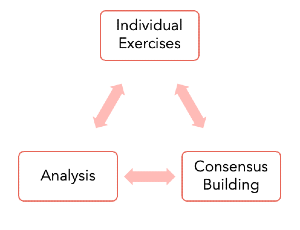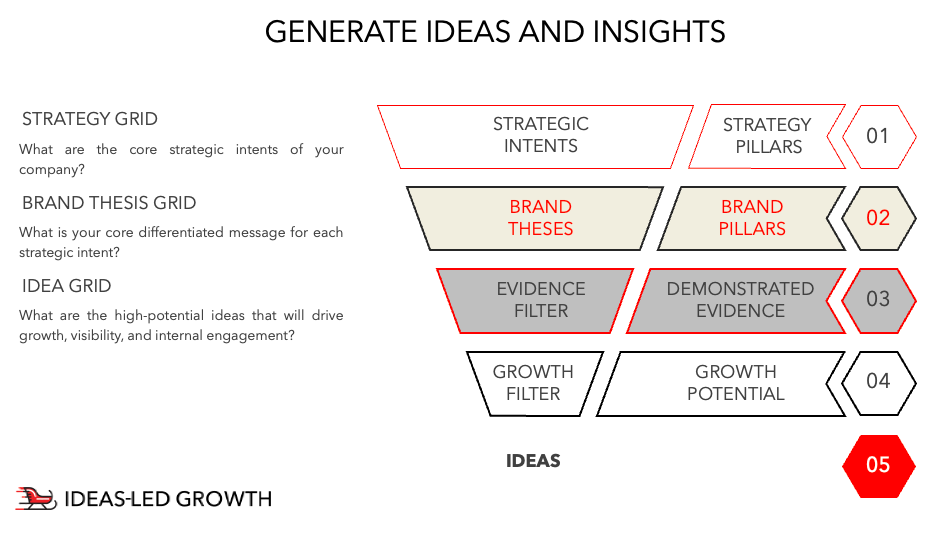How to Generate Ideas

Generating ideas is the first element of the GRACE model for ideas-led growth.
New ideas are the seeds of organizational change and thought leadership. The problem is that few idea-generation methods are up to the task of generating them, let alone in a viable or sustainable way. Even further, most notions of an idea are too vague to result in growth. The idea of an idea itself needs to be redefined.
The Sad Truth About Brainstorming
Brainstorming remains a top choice. Many companies still revert to it as a method of last resort because they know they need to generate ideas and don't have any better options. Leaders accountable for sourcing ideas use brainstorming because it is simple, available, and familiar. However, it falls into conventional wisdom and power dynamics all too quickly. And it lacks a meaningful definition of the "idea" as a unit of activity. No amount of good facilitation can prevent those flaws.
The GRACE-ful method of idea generation provides a systematic, structured, and sequenced alternative to identify ideas.

Generating Ideas That Matter
The process involves working through a set of grids in logical order. Doing so alternates between group-facilitated exercises and activities done individually or by a small team of idea-generation leaders doing exercises and background analysis.
The typical rhythm is individual work on a grid, followed by group consensus-building sessions, from which idea analysts extract concepts for the next round. Using this method culminates in discovery sessions with thought leaders designated to flesh out ideas and to be their public face. It takes between six and eight weeks when done efficiently.

Ideally, strategy, marketing, and product development resources all play a part in the process and have dedicated representation in the working team. An external idea strategist can also help by identifying ideas, clarifying them, and pushing them past common knowledge or stale ideas.
Strategy Stage
What are the core strategic intents of your company?
In the strategy stage, you create a grid of your main strategic pillars and the contexts where they matter. The columns include your main strategic pillars. The rows represent major industry structure trends, industry challenges, market trends, and tech/product trends customized to the specific details of your business. In the cells, you describe your company's strategic intent in a brief statement.

For example:
- The strategic intent for a strategy to capture market share in a rapidly consolidating industry might be to win away clients who feel concerned about service gaps in recently acquired firms.
- The strategic intent for a strategy to become a technology disruptor in your industry might be to tokenize a particular complex asset class.
From this grid, you extract a small number (7–10 max) of priority intents. Prioritization is the primary goal of consensus-building sessions.
Brand Thesis Stage
What is your core differentiated message for each strategic intent?
In the brand thesis stage, you align your prioritized strategic intents and top-line brand messages. The columns represent your main brand pillars. The rows come from the strategy stage.

For example:
- You might have a brand message related to delivering consultative and expert service to clients. If you adopt an intent to win away customers from acquired competitors, your brand thesis could be something like, "Our Account Teams of experienced professionals in our client's industries are structured to maintain service levels without disruption."
- You might have a brand message related to your technology leadership. If you adopt an intent to tokenize an asset class, your brand thesis could be something like, "We provide a platform that provides reliable connection points between counterparties using the Cardano ecosystem."
Admittedly, it's hard to provide generic examples that don't sound like sludge!
From this grid, you extract a small number (again, 7 - 10 max) of your company's most credible, forceful, and differentiated brand theses. Doing so requires consensus building and a separate process of deep competitive analysis.
Idea Stage
What are the high-potential ideas that will drive growth, visibility, and internal engagement?
Here's where we get down to the level of the idea. An idea is the intersection point between your prioritized strategic intents, differentiated brand theses, and demonstrated evidence of delivery. It's not "Oooh, what if we..." And it only counts as an idea for ideas-led growth if it expands your company, increases your reputation, and strengthens employee commitment.
In the idea stage, you map out specific evidence that demonstrates you can and will deliver what your differentiated brand theses say. If your message speaks to uninterrupted service levels, what insights from your head of client services or COO help show that? What case studies prove that? Those are the elements that become the columns of this final grid.
A nuance emerges here, too. The evidence can reflect future plans, recognizing that they might have to come to fruition before they actually lead growth.

For example, to carry through to the end:
- From the service-level brand thesis, your idea might be a proprietary approach to training and retaining talent. That idea becomes the anchor for growth (how you recruit, how you win clients), thought leadership (what you talk about in public), and employee messaging.
- From the Cardano ecosystem brand thesis, your idea might be a proof-of-concept demonstrating an efficient and secure multi-asset ledger approach appropriate for trading in regulated environments.
Summary of the Process
Ideas must have a specific meaning and emerge from a disciplined process to result in growth. However, working with this level of diligence and attention creates an engine for future opportunities anchored in specific ideas articulated by your strongest thought leaders and driving continued innovation.

Three Grace Notes
If you have an idea you’re excited about and you don’t bring it to life, it’s not uncommon for the idea to find its voice through another maker. — Rick Rubin, The Creative Act: A Way of Being
The ability to perform deep work is becoming increasingly rare at exactly the same time it is becoming increasingly valuable in our economy. As a consequence, the few who cultivate this skill, and then make it the core of their working life, will thrive. — Cal Newport, Deep Work: Rules for Focused Success in a Distracted World
The patterns of reciprocity by which mosses bind together a forest community offer us a vision of what could be. They take only the little that they need and give back in abundance. — Robin Wall Kimmerer, Gathering Moss: A Natural and Cultural History of Mosses
Note: The links above are affiliate links. I'm using them in lieu of paid subscription tiers or digital tip jars. Seems like a much more graceful way to generate financial support while sharing more thinking and writing that can guide thought leadership.
